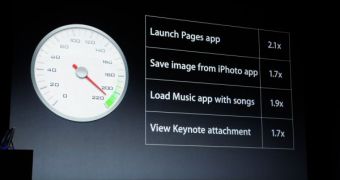The iPhone 5’s processor, which is actually something more complicated called a “system on a chip,” has been thoroughly analyzed over the weekend in order to determine what improvements we can expect beyond Apple’s marketing.
According to the tech-savvy AnandTech, “the A6 is the first Apple SoC to use its own ARMv7-based processor design.”
The hardware review experts note that the processor’s cores aren’t based on a vanilla A9 or A15 design from ARM IP. Instead, the groundwork is something laid by Apple themselves.
The markings on the A6 chip shown both at the iPhone 5 announcement and on Apple’s marketing pages also reveal some technical information, such as the amount of RAM it boasts, its speed, and so on.
“Apple thankfully didn’t obscure the details of its A6 slide at the launch event, which gave us a Samsung part number: K3PE7E700F-XGC2. Through crafty navigation of Samsung’s product guide,” according to the source, which cites Brian Klug as the author of the discovery.
“The K3P tells us we’re looking at a dual-channel LPDDR2 package with 32-bit channels. The E7E7 gives us the density of each of the two DRAM die (512MB per die, 1GB total). The final two characters in the part number give us the cycle time/data rate, which in this case is 1066MHz.”
AnandTech adds that the iPhone 5 memory bandwidth goes beyond that of the iPhone 4S. However, the iPad 3’s A5X chip is still faster on this front, according to the analysis. And it should be. It’s got a lot more stuff to handle at once.
A Geekbench result has emerged over the weekend with its author claiming to have scored 1601 points with the A6 silicon. The test could have easily been faked, as the score beats the A5 by quite a margin. However, there is no indication that the A6 can’t be that powerful.

 14 DAY TRIAL //
14 DAY TRIAL //